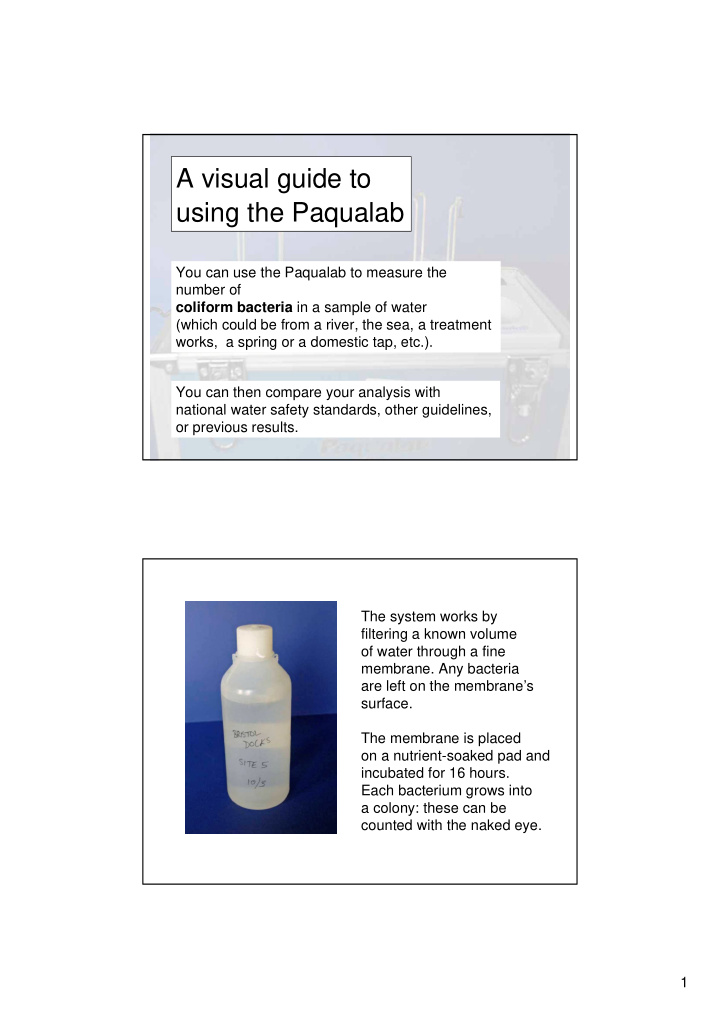



A visual guide to using the Paqualab You can use the Paqualab to measure the number of coliform bacteria in a sample of water (which could be from a river, the sea, a treatment works, a spring or a domestic tap, etc.). You can then compare your analysis with national water safety standards, other guidelines, or previous results. The system works by filtering a known volume of water through a fine membrane. Any bacteria are left on the membrane’s surface. The membrane is placed on a nutrient-soaked pad and incubated for 16 hours. Each bacterium grows into a colony: these can be counted with the naked eye. 1
First, the filter assembly needs to be sterilised. Make sure it’s dry before you start. Add ~ 1ml methanol to the cup with a pipette, and swirl it round gently. 2
Light the methanol carefully with a taper. Quickly invert the filter assembly into the cup and leave it for 15 minutes for the vapour to sterilise the apparatus. 3
Next, prepare a metal petri dish.* Use a permanent marker (not a label) to add details of the sample. *(These should already have been sterilised in an autoclave. If not, add 0.5ml methanol, light, close the lid, and leave it to cool.) Quickly raise the lid of the dish and add a sterile broth pad from the dispenser. 4
Use a plastic pipette to add ~ 2.5ml of the sterile nutrient broth to saturate the pad. Try not to leave the lids off the broth bottle or the petri dish for longer than necessary! The broth contains sodium lauryl sulphate which inhibits the growth of most microbes other than coliforms. It also contains lactose which helps any coliforms multiply quickly. Its colour comes from the pH indicator phenol red. If coliforms are present their colonies will be yellow because of the acidic products formed when they metabolise lactose. 5
Next you need to filter your water sample. First, re-invert the filter assembly. Remove the top part of the filter assembly. Using flamed tweezers, remove the top white rubber ring and place it somewhere uncontaminated. 6
Use the tweezers to remove a gridded membrane (minus its blue backing) from its sterile packet. Place the membrane, grid side up, onto the lower white ring. 7
Then replace the upper ring... (where are the model’s gloves?) ... and replace the funnel section. Don’t press too hard or you may find it difficult to remove later. 8
If too many bacteria end up on the filter there’ll be too many colonies to count. Ideally you want no more than 200 per dish. You have to choose the volume of sample to filter, according to its source. If in doubt you can repeat the test using several volumes. Distribution system (treatment works to user) – 100ml Water treatment works (treated) – 100ml Water treatment works (partially treated) – 100ml or 50ml (or less) Wells, boreholes and other protected sources – 50ml (or more or less) Lakes, reservoirs and other surface water sources – 10ml (or more) Farm ponds – < 1ml (add sterile water when filtering) Raw sewage – < 0.1ml (add sterile water when filtering) Add the chosen volume of water to the funnel. 9
Attach a vacuum bulb (make sure it’s the right way round!) and squeeze to draw the water through the filter. Disassemble the funnel and remove the top ring with tweezers... 10
Then quickly open the petri dish and add the membrane, grid side up. *Empty the water from the container or it’ll overflow into your pump next time.* You may want to add the volume used to the labelling on the dish. 11
Add the petri dish to one of the metal holders. You would usually duplicate this dish so one could be incubated at 37 ˚ and the other at 44 ˚ . Coliforms are found in soil and submerged wood, as well as the faeces of warm-blooded animals. The test at 37 ˚ (once called ‘total coliforms’ but now ‘coliform bacteria’) shows whether any at all are present. It’s a useful test on drinking water because it can indicate a contamination source exists. Only E. coli (from faeces) can survive at 44 ˚ , suggesting pollution from agricultural run-off or human sewage. A positive result also acts as an indicator that other pathogenic bacteria and viruses could be present. Add the dishes to the incubators, put on the lids and leave for 16 hours. 12
Put the used equipment in disinfectant or bleach. After incubation, check each dish for colonies. Count all egg-yolk yellow colonies 1mm+ in diameter (don’t count translucent or pink colonies). If necessary, convert your result to the standard format of coliforms per 100ml sample. 13
If you’re in the field and the used dishes can’t be autoclaved immediately, disinfect them. Gloves and tissues can be sealed in a biohazard bag. Drinking Water Standards The Water Supply (Water Quality) Regulations 2000 for England and Wales state that there should be: 0 Coliform bacteria (previously, ‘total coliforms’) per 100ml 0 E. coli (previously, ‘faecal coliforms’) per 100ml. Bathing Water Standards The minimum legal standards as required by the Bathing Water Directive are (for 19 out of 20 samples taken): A maximum of 10,000 coliform bacteria per 100ml water A maximum of 2,000 E. coli per 100ml water The stricter guideline standards are (for 16 out of 20 samples taken): A maximum of 500 coliform bacteria per 100ml water A maximum of 150 E. coli per 100ml water. The Blue Flag standard includes a water quality test that demands 18 out of 20 samples have no more than 100 E. coli per 100ml water. 14
Recommend
More recommend